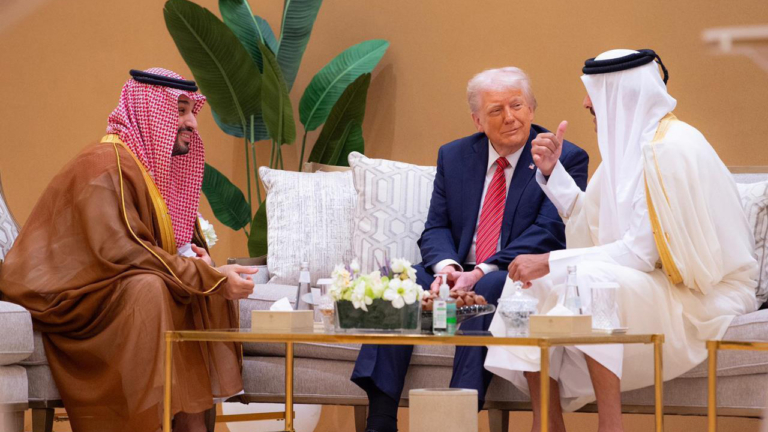
Last week President Donald Trump ended a three-country trip to the Arabian Gulf—Saudi Arabia, Qatar, and the United Arab Emirates—where he signed lucrative arms and business deals and got commitments from his hosts to make huge investments in the American economy. Unlike his trip to the region during his first term, in May 2017, this one did not include a stop in Israel and a meeting with Prime Minister Benjamin Netanyahu but came amid radical changes in American foreign policy under Trump’s watch. In the Middle East, the president has authorized direct negotiations with Iran about its nuclear program; his representatives have negotiated the release of an American-Israeli detainee in direct talks with Hamas; and he has called for an end to Israel’s war on Gaza, in obvious opposition to Netanyahu’s desire to continue the conflict there.
During his trip to the three Gulf Cooperation Council countries, the president made dramatic announcements regarding hot-button issues at the heart of American policy in the Middle East. Offering to continue the diplomatic path with Iran, Trump said he was willing to countenance more economic pressure on the Islamic Republic, but discounted the talk of a military solution to its nuclear dilemma. The US president announced plans to lift sanctions on Syria and even met with the Syrian president, Ahmed al-Sharaa, formerly the leader of an al-Qaeda affiliate in Syria. Trump also seemed to quiet speculation about a normalization deal between Saudi Arabia and Israel, an American wish since at least his first term, instead stating that the kingdom would do so on its own time.
Arab Center Washington DC (ACW) asked its analysts to provide their perspectives on different aspects of President Trump’s trip to the Gulf and his policy pronouncements. Their commentaries are below.
What Domestic Political Price Is Trump Likely to Pay for Sidelining Netanyahu?
Charles W. Dunne, Non-resident Senior Fellow
One of the more remarkable aspects of President Trump’s visit to the Middle East, in a trip full of them, was something that did not occur: a stop in Israel. Most US presidents would not have missed the opportunity.
The omission follows other recent instances where Israel was cut out. These include negotiations with the Houthis to end attacks on American shipping in the Red Sea; talks with Iran on its nuclear program; negotiations between Middle East envoy Steve Witkoff and Hamas, which may have helped lead to the release of the sole remaining American hostage; Trump’s lifting of sanctions on Syria and meeting in Riyadh with new president Ahmad al-Sharaa, a former top Al-Qaeda figure. Israel opposed all these moves, but Trump went ahead with them anyway. Additionally, Trump’s ouster of his national security adviser, Mike Waltz, was reportedly partly due to the latter’s close coordination with the Netanyahu government on Iran strikes, which Trump (for now) opposes.
In normal political times, any US president who compiled such a record of ignoring or opposing Israel would have suffered a bad case of political indigestion. But Trump appears to have insulated himself against criticism that would have damaged anyone else.
In his first term, Trump checked almost every box on Israel’s diplomatic wish list, from recognition of its sovereignty over the occupied Golan Heights to moving the US Embassy to Jerusalem. A US “peace” plan cut out the Palestinians from any meaningful role in deciding their own future, as did Trump’s singular diplomatic achievement, the Abraham Accords. Since returning to office in January 2025, Trump has lifted Biden-era restrictions on arms sales to Israel and largely ignored the conflict in Gaza, leaving the field open for Netanyahu to operate as he sees fit, at least for the moment. Trump has bought himself a lot of leeway to deal with Israel as he wishes.
Trump also retains a firm grip on Republicans in Congress and conservative white evangelical voters, many of whom are staunch supporters of Israel and helped re-elect him. Many Democrats may welcome some Trump moves to sideline Israel and advance diplomatic approaches to Iran and Syria. And the numerous controversies swirling around the administration’s policies concerning fundamental issues such as tariffs, federal spending cuts, and an erosion of the rule of law drown out relatively minor foreign policy considerations. It thus seems unlikely that Trump’s manhandling of Netanyahu will come with a hefty political price tag.
Has Trump Nixed Normalization?
Dana El Kurd, Non-resident Senior Fellow
President Trump’s visit to the Middle East has only confirmed that Arab-Israeli normalization will not proceed, at least anytime soon, in the form of the Abraham Accords signed during the first Trump administration. As he acknowledged in his speech in Saudi Arabia, dynamics have shifted and the Saudis in particular would come to normalization “in their own time.” This was a clear acknowledgment that Arab-Israeli normalization, predicated on building authoritarianism alliances with little to no incorporation of the Palestinian question, would not be the exact model for Saudi Arabia. Instead, the Trump administration used the president’s Gulf tour to push fragile Syria to normalize with Israel, with the prospect of a Saudi-Israeli deal quickly receding.
It is unsurprising that President Trump has come to this conclusion. Saudi Arabia is not the United Arab Emirates (UAE) or Bahrain and has no reason to enter into agreements with Israel and the United States without securing enormous concessions. A defense treaty with the United States, help in developing civilian nuclear energy, and meaningful steps to Palestinian statehood were all demands by the kingdom discussed during the Biden administration; regional dynamics have only shifted more in Saudi Arabia’s favor since. The threat of Iran has been neutralized, for now, and support for the Palestinian cause has skyrocketed as the genocide in Gaza has unfolded, further reducing the likelihood of Saudi-Israeli normalization.
Saudi Arabia and the other Arab states have had a lot more space to reject the Trump administration’s various proclamations about ethnically cleansing the Gaza Strip, and indeed have moved unilaterally to put forth their own plans and are pressuring the Palestinian Authority to move in particular directions in anticipation of those plans. Specifically, this has meant pressuring Palestinian President Mahmoud Abbas to create a new vice president position and appoint Hussein al-Sheikh, someone suitable to Arab regimes, as his successor.
Ironically, the Israeli state’s intransigence has played into reducing the likelihood of Arab-Israeli normalization. The ever-intensifying extremism of the Israeli government, intent on maximalist goals of ethnic cleansing and armed by the United States, has undoubtedly shown Arab regimes that there is no space for negotiation—on the Palestinian question or anything else. Instead, engagement with Israel on an official basis only serves as a liability, especially as Israel so decisively ignores international law. Furthermore, the Palestinian cause remains a motivator for Arab public dissent, and pursuing alliances with the Israeli state under these conditions only opens these regimes up to potentially explosive opposition from their own people.
Even more ironically, the Trump administration is willing to sidestep the Israeli government in ways the Biden administration never attempted or even considered. Indeed, recent reporting has confirmed that the Trump administration has conducted direct talks with Hamas, as well as with Saudi Arabia about its goal of a civilian nuclear program “de-linked” from normalization with Israel. Arab-Israeli normalization has only ever been a facade for authoritarian conflict management, not peace. The recent war in Gaza has done away with its utility even on this front.
Significance of Trump’s Announcement Regarding Syria
Imad K. Harb, Director of Research and Analysis
The president’s announcement about lifting American sanctions on Syria was a radical change from American foreign policy toward the country since even before the start of its civil war in 2011. Lifting the sanctions would allow the battered country and its government not only to reestablish long-severed relations with Arab and other countries but also to seek new economic ties essential for its recovery and reconstruction, especially with international lending institutions such as the International Monetary Fund and the World Bank. Furthermore, Trump’s meeting with Syrian President Ahmed al-Sharaa bestowed long sought legitimacy upon the former jihadi fighter and informed the international community that Syria is now open for business.
Significantly, while President Trump urged Sharaa to normalize his country’s relations with Israel, his recognition of the Syrian president’s legitimacy and wish for Syrians to achieve what the US leader called “greatness” is a message to Israel to curb its territorial ambitions at the expense of its northern neighbor. This should not be seen as if Trump wants to deny Israel what it covets from a weak Syria, but as notification to the Netanyahu government not to completely alienate Sharaa, supported as he is by Saudi Arabia, or weaken him further. After all, the Syrian president today appears to be the man of the hour to lead that country in the post-Assad period and keep it at a desired distance from Iran. Sharaa also appears to be the one who can keep Syria from falling apart, as Syria’s collapse affects Israel’s and the region’s security and as the so-called Islamic State keeps reminding everyone, including the United States, that it is quite capable of regenerating itself in Syria.
Lifting the sanctions on Syria and treating it like a normal country will allow the Gulf countries—with which good relations are dear to Trump—to contribute to Syria’s reconstruction and recovery. There is no accurate, and internationally recognized, estimate of the cost of Syria’s reconstruction and rehabilitation, but it is expected to run in the hundreds of billions of dollars. The Gulf Arab states are the most financially capable to provide at least part of that amount, some of which will likely be in grants, but the rest will require not only Gulf investment ventures but also international financing. Indeed, Syria after the Trump announcement could very well become a hub of economic activity, investment opportunities, and the site of employment for millions of destitute Syrians, many of whom are refugees in neighboring countries. Their return to participate in the reconstruction of their country undoubtedly will affect the job market in their current host countries and may even attract foreign workers from such places as Lebanon, Iraq, Jordan, and Turkey, to name a few.
Did Trump Shrug off Netanyahu in His Gulf Trip?
Khalil E. Jahshan, Executive Director
President Trump’s four-day visit to Saudi Arabia, Qatar, and the UAE, the first major foreign trip of his second term, just concluded with conflicting claims of diplomatic victory, on the one hand, and dismal failure and irrelevance to the region, on the other. Aside from securing more than $2 trillion in investments from his Arab hosts in arms sales, artificial intelligence, and aviation, the 2025 trip is reminiscent of the president’s first-term visit to the region in 2017 when he left the politically turbulent region a bigger mess than he found it. Claims by White House aides and others that, this time around, POTUS 47 dramatically reset US foreign policy, reshaped the Middle East’s diplomatic map, and fostered greater safety and stability in the region remain premature at best.
The coverage of the diplomatic journey was a bonanza for the US and international media, particularly Arabic language outlets. Various aspects of the trip were deeply scrutinized, including its economic and political objectives, timing, the president’s own performance, his reception in the region, and resulting commercial agreements. But two main critical topics tended to dominate the coverage: first, Trump’s apparent enthusiasm to accept a $400 million Boeing 747-8 super-luxury jet from Qatar to replace the aging Air Force One, and second, widespread speculation about alleged political differences revealed during the trip between the president and Israeli Prime Minister Benjamin Netanyahu.
The overwhelming trend of media coverage on this second issue was focused on a perceived yet exaggerated growing rift between Washington and Tel Aviv over a range of issues that traditionally required extensive coordination between the two allies. Reporters pointed out convincingly that issues pertaining to ending the war in Gaza, pursuing a new nuclear deal with Iran, US efforts to normalize Israel’s relations with the Arab world, massive arms sales to Arab allies, and recognizing the new government in Syria were not issues with which Washington dealt in the past without consultation with Israeli governments. However, many analysts and reporters critical of Netanyahu tended to overstate the superficial tensions between Trump and Netanyahu in order to embarrass the latter.
President Trump felt compelled to personally downplay the controversy by telling FOX News that “he is not frustrated” with Netanyahu, insisting that he understands his “anger over Hamas.” Frankly, although the president might have purposely kept the Israeli government isolated and out of sight throughout his trip to the region to achieve his objectives, Trump did not hide at all his well-known bias for Israeli policies, whether in Palestine, Syria, Yemen or elsewhere. He stuck with his earlier commitments to Arab normalization with Israel, although acknowledging that it will not happen soon, and was quite adamant about his mass displacement plan for the population of Gaza. As pointed out by the Los Angeles Times, Trump’s “trip produced little for Palestinians” in terms of ending the war in Gaza. That cannot be classified by any standard as the result of a serious rift between the two allies. Anticipated US diplomatic follow up over the next few weeks, including a vice-presidential trip to Israel, will prove that beyond the shadow of a doubt.
How Trump’s Middle East Trip May Impact His Views on Iran?
Assal Rad, Scholar of Modern Middle Eastern history; Non-resident Fellow, DAWN
As in his first term in office, President Trump chose the Gulf for his first major international trip. Today, however, the regional landscape is markedly different from his visit in 2017. Most notable, of course, is Israel’s unfolding genocide in Gaza and the post-October 7 transformation of the region, including the overall weakening of Iran’s so-called Axis of Resistance.
While 2017 was a time of heightened tensions between Saudi Arabia and Iran—and perhaps a greater inclination toward conflict—the Gulf states in 2025 are more aligned in cautious cooperation with Tehran. At the same time, Israel’s destruction of Gaza has soured, at least for now, the process of normalization that the first Trump administration touted as a historic success under the Abraham Accords.
The dramatic shift in regional dynamics—and the 2023 rapprochement between Saudi Arabia and Iran—reflects their political pragmatism. China’s forward-looking role in brokering that deal illustrates the larger changes in global politics and challenges to American dominance in the Middle East. Reconciliation and integration have become a driving force for regional development. Qatar—which suffered diplomatic isolation from its Arab neighbors during the first Trump presidency, in part over its relations with Iran—now represents a model of diplomatic pragmatism.
Today, these states are focused on their own ambitious national projects, which would undoubtedly be encumbered by serving as battlegrounds for US-Iran tensions or Israel’s relentless attacks. From Vision 2030 in Saudi Arabia to the UAE’s efforts toward innovation and tourism, the appetite for regional stability currently outweighs any ideological drive for confrontation.
This regional recalibration may not only shape Trump’s perspective but also offer him a political opportunity. In contrast to his first term, when Gulf states supported his “maximum pressure” campaign against Iran, now regional actors are encouraging dialogue about a deal with Tehran. This appears to be in line with the desires of President Trump himself and his fondness for dealmaking. Iranian officials have also signaled their wish for an agreement, using the language of economic cooperation and mutual benefit that aligns closely with Trump’s transactional worldview.
The countries of the Middle East do not want to be the staging ground for American adventurism or Israeli aggression. Instead, they increasingly view a US-Iran deal as a practical path toward stability and prosperity. If Trump is serious about securing a foreign policy win, a diplomatic opening with Iran—backed by regional partners—could provide a strategic pivot.
Has Trump Realigned US Foreign Policy to Favor the Gulf States?
Annelle Sheline, Non-resident Fellow; Research Fellow, Quincy Institute
As American policy has long favored the Gulf Arab states, Trump’s trip does not signify a realignment of US foreign policy. But it affirms Trump’s appreciation for the lavish reception that he received in Riyadh, Doha, and Abu Dhabi. Trump and the leaders of the wealthy Gulf states embrace a similarly ostentatious aesthetic and authoritarian worldview.
Trump needed some foreign policy wins after making and breaking grandiose promises about swiftly ending the war in Ukraine and bringing peace to the Middle East. The Saudi, Qatari, and Emirati rulers had previously demonstrated their willingness to bolster Trump’s self-image as a master dealmaker by purchasing vast amounts of American weapons and airplanes, not to mention by enriching Trump personally, such as investing in his and his family members’ businesses.
In return, Trump has signaled his alignment with the preferences of Gulf monarchs to try to avoid unnecessary conflict in their region, which those rulers fear would threaten their economic development and stability. By abruptly declaring a ceasefire with Yemen’s Ansar Allah, also known as the Houthis, negotiating with Iran, and lifting sanctions on Syria, Trump’s approach also reflects the desires of his American political base to avoid getting the United States entangled in more “forever wars.”
In this approach, the president is indeed signaling a new direction for American foreign policy. Trump’s speech in Riyadh criticizing America’s record of failed military interventions and so-called nation building does represent a departure from recent American presidents.
By eschewing the rhetoric of the United States as a global model to be emulated and instead commending Gulf leaders and societies for their own achievements, Trump is articulating the possibility of a new paradigm for America’s global role. For those who continue to believe in the myth that the United States is a unique force for good in the world, Trump’s stance will appear to abandon American ideals of democracy and human rights. However, for the many—especially in the Global South—who had long known that US foreign policy had never been driven by such noble principles and who instead observed or experienced that America’s primary export was not freedom but violence, Trump’s stance offers an unusual forthrightness without the rhetoric about ideals and grandiose visions.
If Trump follows through and pursues a less militaristic foreign policy, his Riyadh speech is likely to be remembered with significantly more appreciation than former president Barack Obama’s much-touted Cairo speech of 2009, which despite anticipation, largely failed to herald a new era in America’s approach to the Middle East.
The views expressed in this publication are the authors’ own and do not necessarily reflect the position of Arab Center Washington DC, its staff, or its Board of Directors.
Featured image credit: SPA






